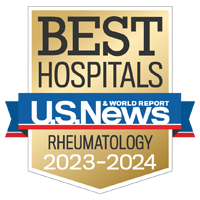Scleroderma

Overview
Scleroderma is a rare and chronic condition that can affect many parts of your body including the skin, joints, blood vessels and internal organs. The word "scleroderma" means hard skin. One of the most visible symptoms of the condition, also called systemic sclerosis, is hardening or thickening of the skin. The disease affects women three to five times more often than men and usually develops between the ages of 30 to 50, but can occur in children and the elderly.
Scleroderma can be limited, affecting mainly the hands and face, or diffuse, affecting the arms, legs and trunk. Symptoms can vary widely from arthritis and muscle weakening to kidney problems.
The disease involves an excess amount of a protein – called collagen – deposited in the skin and organs, which leads to the thickening and hardening of the skin.
The condition is not contagious or infectious, and the cause is unknown.
Many medications are available to help treat the condition and control symptoms, but there is not yet a cure.
Our Approach to Scleroderma
UCSF provides comprehensive evaluations and advanced care for scleroderma. Because scleroderma can affect different systems in the body, our team includes several types of doctors, such as rheumatologists, dermatologists and plastic surgeons who focus on autoimmune disease. We also work closely with colleagues who specialize in interstitial lung disease, pulmonary hypertension and other potential complications of scleroderma.
Treatment options include medications to address symptoms and complications of scleroderma. We also recommend exercise and physical therapy to increase flexibility and protect joints. Although there is currently no cure for scleroderma, we are dedicated to alleviating patients' suffering.
We are also dedicated to improving the understanding and treatment of scleroderma through research. Interested patients may have the option to receive investigational treatments by participating in clinical trials.
Awards & recognition
-

Among the top hospitals in the nation
-

Best in California and No. 7 in the nation for rheumatology
Signs & symptoms
Scleroderma can affect everyone differently. The following are some of the general symptoms associated with the condition.
Skin changes, including:
- Hardening of your skin, particularly on your hands, arms and face, and occasionally on your trunk and legs
- Loss of hair over the affected area
- Change in skin color
- Ulcers or sores on your fingers
Swelling or puffiness in your hands or feet, often occurring in the morning.
A condition called sclerodactyly, which is the thickening or hardening of the skin of the fingers and toes, also can occur. This may develop after the initial swelling goes away and may be followed by the shrinking or atrophy of skin. You may experience:
- Skin on your fingers and toes becoming hard and shiny
- Difficulty bending your fingers
Raynaud's Phenomenon, a condition associated with poor blood flow to fingers and toes. Blood flow decreases because blood vessels in these areas become narrow for a short time in response to cold or emotional stress. Raynaud's Phenomenon may cause:
- Your fingers, toes, tips of your ears, nose or tongue to be very sensitive to cold
- Your fingers to turn bluish or very pale
- Your fingers to feel tingly, numb or cold
Telangiectasia, which occurs when tiny blood vessels become dilated and show through your skin. Small reddish spots may appear on your fingers, palms, face, lips and tongue. These spots are harmless and can be hidden with cosmetics.
Calcinosis, which occurs when small white calcium lumps form in or under the skin. It is caused by scleroderma and not by too much calcium in your diet. The lumps occasionally break through the skin and leak a chalky, white material. If injured, they may become infected.
Arthritis and muscle weakness, including:
- Pain, stiffness and swelling
- General fatigue
- Muscle weakness, often in your upper arms or thighs
Digestive problems including poor function of your esophagus and bowels. Symptoms may include:
- Difficulty swallowing
- Heartburn
- Bloating
- Nausea or vomiting
- Weight loss
- Diarrhea or constipation
If the heart and lungs are affected, you may experience:
- Shortness of breath
- Persistent cough
- Chest pain
Kidney problems, such as kidney failure and high blood pressure. Symptoms may include:
- Fatigue
- Severe headache
- Shortness of breath
- Trouble seeing
- Mental confusion
Diagnosis
If you think that you may have scleroderma, you should visit your doctor immediately. Your doctor will begin by conducting a thorough physical examination and asking about your symptoms and medical history.
Laboratory tests can assist with diagnosis. These usually include blood tests, but occasionally involve tests of lung, heart or digestive function or a biopsy of affected tissues.
Treatments
Drug Therapy
Although there is no current cure for scleroderma, there are many drugs available to help control it, including:
- Aspirin or nonsteroidal anti-inflammatory drugs (NSAIDs) to treat joint pain and swelling
- Steroids to treat muscle and joint problems
- Antacids to relieve heartburn and intestinal motion and to protect the esophagus and stomach
- Medication to treat high blood pressure
- Drugs to treat Raynaud's phenomenon by increasing blood flow to your fingers and toes
Exercise
Exercise is very important for people with scleroderma because it increases skin and joint flexibility, promotes blood flow and prevents contractures. Your doctor and physical therapist can work with you to develop a healthy exercise plan.
Joint Protection
You can reduce stress and injury to your joints by learning to perform daily activities in a special way. Occupational and physical therapists can teach you ways to relieve pain and increase function through joint protection.
Skin Protection
You can protect your skin from injury by:
- Keeping your body warm to help open blood vessels in your arms, hands, legs and feet
- Using a cold-water humidifier to keep your skin moist
- Avoiding strong detergents or other substances that may irritate your skin
- Trying soaps, creams and bath oils that prevent dry skin
- Leaving calcium deposits alone
- Keeping finger ulcers clean
Stress Management
Living with a chronic disease may cause social and emotional stresses. Talk to your doctor or other members of your health care team about ways to reduce stress and fatigue.
UCSF Health medical specialists have reviewed this information. It is for educational purposes only and is not intended to replace the advice of your doctor or other health care provider. We encourage you to discuss any questions or concerns you may have with your provider.









